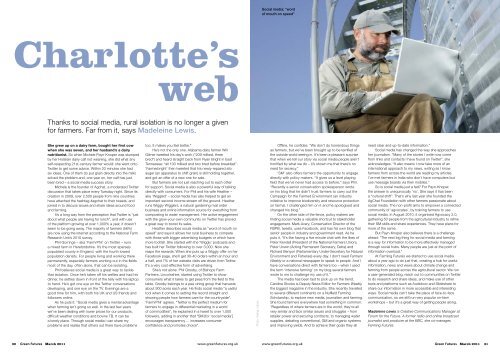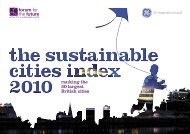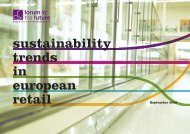TOMORROW'S FOOD, TOMORROW'S FARMS - Forum for the Future
TOMORROW'S FOOD, TOMORROW'S FARMS - Forum for the Future
TOMORROW'S FOOD, TOMORROW'S FARMS - Forum for the Future
Create successful ePaper yourself
Turn your PDF publications into a flip-book with our unique Google optimized e-Paper software.
Charlotte’s<br />
web<br />
Thanks to social media, rural isolation is no longer a given<br />
<strong>for</strong> farmers. Far from it, says Madeleine Lewis.<br />
She grew up on a dairy farm, bought her first cow<br />
when she was seven, and her husband’s a dairy<br />
nutritionist. So when Michele Payn-Knoper was stumped<br />
by her Holstein dairy calf not weaning, she did what any<br />
self-respecting 21st-century farmer would: she went onto<br />
Twitter to get some advice. Within 20 minutes she had<br />
six ideas. One of <strong>the</strong>m (to put grain directly into <strong>the</strong> milk)<br />
solved <strong>the</strong> problem and, one year on, her calf has just<br />
been bred – a social media success story.<br />
Michele is <strong>the</strong> founder of Agchat, a moderated Twitter<br />
discussion that takes place every Tuesday night. Since its<br />
creation in 2009, over 2,500 people from nine countries<br />
have attached <strong>the</strong> hashtag #agchat to <strong>the</strong>ir tweets, and<br />
joined in to discuss issues and share ideas around food<br />
and farming.<br />
It’s a long way from <strong>the</strong> perception that Twitter is “just<br />
about what people are having <strong>for</strong> lunch”, and with use<br />
of <strong>the</strong> plat<strong>for</strong>m growing at over 1,000% a year, it doesn’t<br />
seem to be going away. The majority of farmers (56%)<br />
are now using <strong>the</strong> internet according to <strong>the</strong> National Farm<br />
Research Unit’s 2010 survey.<br />
Phil Gorringe – aka ‘FarmrPhil’ on Twitter – runs<br />
a mixed farm in Here<strong>for</strong>dshire. It’s <strong>the</strong> most sparsely<br />
populated county in England, with <strong>the</strong> fourth lowest<br />
population density. For people living and working <strong>the</strong>re<br />
permanently, especially farmers working out in <strong>the</strong> fields<br />
most of <strong>the</strong> day, often alone, that can be isolating.<br />
Phil believes social media is a great way to tackle<br />
that isolation. Once he’s taken off his wellies and had his<br />
dinner, he settles down in front of <strong>the</strong> telly with his laptop<br />
to hand. He’s got one eye on <strong>the</strong> Twitter conversations<br />
developing, and one eye on <strong>the</strong> TV. Evenings are a<br />
good time <strong>for</strong> him, with both his UK and US friends and<br />
followers online.<br />
As he puts it: “Social media gives a mental advantage<br />
when farming isn’t going so well. In <strong>the</strong> last few years<br />
we’ve been dealing with lower prices <strong>for</strong> our products,<br />
difficult wea<strong>the</strong>r conditions and bovine TB. It can be<br />
a lonely place. Through social media I can share my<br />
problems and realise that o<strong>the</strong>rs out <strong>the</strong>re have problems<br />
too. It makes you feel better.”<br />
He’s not <strong>the</strong> only one. Alabama dairy farmer Will<br />
Gilmer tweeted his day’s work (“209 milked, three<br />
bred”) and heard straight back from Ryan Bright in East<br />
Tennessee: “all 100 milked and two bred be<strong>for</strong>e breakfast”.<br />
‘Farmerbright’ <strong>the</strong>n tweeted that his newly-repaired silo<br />
auger (an apparatus to shift grain) is still holding toge<strong>the</strong>r,<br />
and got an offer of a new one <strong>for</strong> sale.<br />
But farmers are not just reaching out to each o<strong>the</strong>r<br />
<strong>for</strong> support. Social media is also a powerful way of talking<br />
directly with consumers. For Phil and his wife Hea<strong>the</strong>r –<br />
aka ‘Wiggled’ – social media has also helped to get an<br />
important second income stream off <strong>the</strong> ground. Hea<strong>the</strong>r<br />
runs Wiggly Wigglers, a natural gardening mail order<br />
business and online in<strong>for</strong>mation source <strong>for</strong> everything from<br />
composting to water management. Her active engagement<br />
with <strong>the</strong> grow-your-own community on Twitter has proved<br />
a great way to boost its sales.<br />
Hea<strong>the</strong>r describes social media as “word of mouth on<br />
speed” and says it allows her rural business to compete<br />
with those with bigger advertising budgets or which have<br />
more footfall. She started with <strong>the</strong> ‘Wiggly’ podcasts and<br />
has built her Twitter following to over 3,000. Now she<br />
reaps <strong>the</strong> rewards. When she puts up a Wiggly offer on her<br />
Facebook page, she’ll get 30-40 orders within an hour and<br />
a half, and 7% of her website visits are driven from Twitter.<br />
It’s a very cost-effective <strong>for</strong>m of advertising.<br />
She’s not alone. Phil Grooby, of Bishops Farm<br />
Partners, Lincolnshire, started using Twitter to show<br />
consumers what it takes to get peas from <strong>the</strong> field to <strong>the</strong><br />
table. Grooby belongs to a pea vining group that harvests<br />
about 900 acres each year. He finds social media “a useful<br />
tool when it comes to setting <strong>the</strong> record straight and<br />
showing people how farmers care <strong>for</strong> <strong>the</strong> countryside”.<br />
‘FarmrPhil’ agrees. “Twitter is <strong>the</strong> perfect medium <strong>for</strong><br />
farmers to engage in differential marketing in a world<br />
of commodities”, he explained in a tweet to over 1,000<br />
followers, adding in ano<strong>the</strong>r that “SM [<strong>for</strong> ‘social media’]<br />
encourages transparency ... increases consumer<br />
confidence and promotes choice”.<br />
Offline, he confides: “We don’t do horrendous things<br />
as farmers, but we’ve been brought up to be terrified of<br />
<strong>the</strong> outside world seeing in. It’s been a pleasant surprise<br />
that when we tell our story via social media people aren’t<br />
horrified by what we do – it’s shown me that <strong>the</strong>re’s no<br />
need <strong>for</strong> secrecy.”<br />
‘SM’ also offers farmers <strong>the</strong> opportunity to engage<br />
directly with policy makers. “It gives us a level playing<br />
field that we’ve never had access to be<strong>for</strong>e,” says Phil.<br />
“Recently a senior conservation spokesperson wrote<br />
on his blog that he didn’t trust farmers to carry out <strong>the</strong><br />
Campaign <strong>for</strong> <strong>the</strong> Farmed Environment (an industry<br />
initiative to improve biodiversity and resource protection<br />
on farms). I challenged him on it and he apologised and<br />
changed his blog.”<br />
On <strong>the</strong> o<strong>the</strong>r side of <strong>the</strong> fence, policy makers are<br />
finding social media a valuable shortcut to stakeholder<br />
engagement. Mark Avery, Conservation Director of <strong>the</strong><br />
RSPB, tweets, uses Facebook, and has his own blog that<br />
senior people in industry and government read. As he<br />
puts it, “It’s like having a five minute chat with <strong>the</strong> likes of<br />
Peter Kendall (President of <strong>the</strong> National Farmers Union),<br />
Peter Unwin (Acting Permanent Secretary, Defra) and<br />
Richard Benyon (Parliamentary Under-Secretary <strong>for</strong> Natural<br />
Environment and Fisheries) every day. I don’t need Farmers<br />
Weekly or a national newspaper to speak to people. And I<br />
have conversations direct with farmers too – when I used<br />
<strong>the</strong> term ‘intensive farming’ on my blog several farmers<br />
wrote to me to challenge my use of it.”<br />
The media has been fast to pick up on <strong>the</strong> trend.<br />
Caroline Stocks is Deputy News Editor <strong>for</strong> Farmers Weekly,<br />
<strong>the</strong> biggest magazine in <strong>the</strong> industry. She recently travelled<br />
to several different continents on a Nuffield Farming<br />
Scholarship, to explore new media, journalism and farming.<br />
She found farmers everywhere had something in common:<br />
“Regardless of where farmers are in <strong>the</strong> world, <strong>the</strong>y’re all<br />
very similar and face similar issues and struggles – from<br />
retailer power and securing contracts, to managing water<br />
supplies, debating conventional, GM and organic systems<br />
and improving yields. And to achieve <strong>the</strong>ir goals <strong>the</strong>y all<br />
need clear and up-to-date in<strong>for</strong>mation.”<br />
Social media has changed <strong>the</strong> way she approaches<br />
her journalism. “Many of <strong>the</strong> stories I write now come<br />
from links and contacts I have found on Twitter”, she<br />
acknowledges. “It also means I now take more of an<br />
international approach to my news, writing as I know<br />
farmers from across <strong>the</strong> world are reading my articles.<br />
I’ve met farmers in India who don’t have computers but<br />
use message boards via <strong>the</strong>ir mobiles.”<br />
So is social media just a fad? For Payn-Knoper,<br />
<strong>the</strong> answer is unequivocally ‘no’. She says it has been<br />
a “cultural shift”. That’s why last year she founded <strong>the</strong><br />
AgChat Foundation with o<strong>the</strong>r farmers passionate about<br />
social media. The non-profit aims to empower a connected<br />
community of ‘agvocates’, by training farmers to use<br />
social media. In August 2010, it organised Agvocacy 2.0,<br />
ga<strong>the</strong>ring 50 people from <strong>the</strong> agricultural industry to refine<br />
<strong>the</strong>ir SM skills and share experiences. They have plans <strong>for</strong><br />
more of <strong>the</strong> same.<br />
But Payn-Knoper also believes <strong>the</strong>re is a challenge<br />
ahead: “The next big thing <strong>for</strong> social media and farming<br />
is a way <strong>for</strong> in<strong>for</strong>mation to be more effectively managed<br />
through social hubs. Many people are just at <strong>the</strong> point of<br />
in<strong>for</strong>mation overload.”<br />
At Farming <strong>Future</strong>s we started to use social media<br />
about a year ago to do just that, creating a hub <strong>for</strong> useful<br />
in<strong>for</strong>mation, news and views about climate change and<br />
farming from people across <strong>the</strong> agricultural sector. We run<br />
a user-generated blog, reach out to communities on Twitter<br />
to do research and share ideas, and make use of o<strong>the</strong>r<br />
tools and plat<strong>for</strong>ms such as Audioboo and Slideshare to<br />
share our in<strong>for</strong>mation in more accessible and interesting<br />
ways. Social media can’t take <strong>the</strong> place of face-to-face<br />
communication, so we still run very popular on-farm<br />
workshops – but it’s a great way of getting people along.<br />
Madeleine Lewis is Creative Communications Manager at<br />
<strong>Forum</strong> <strong>for</strong> <strong>the</strong> <strong>Future</strong>. A <strong>for</strong>mer radio and online broadcast<br />
journalist and producer at <strong>the</strong> BBC, she co-manages<br />
Farming <strong>Future</strong>s.<br />
30 Green <strong>Future</strong>s March 2011 www.greenfutures.org.uk<br />
www.greenfutures.org.uk Green <strong>Future</strong>s March 2011 31<br />
Photo: Fertnig / istock<br />
Social media: “word<br />
of mouth on speed”








